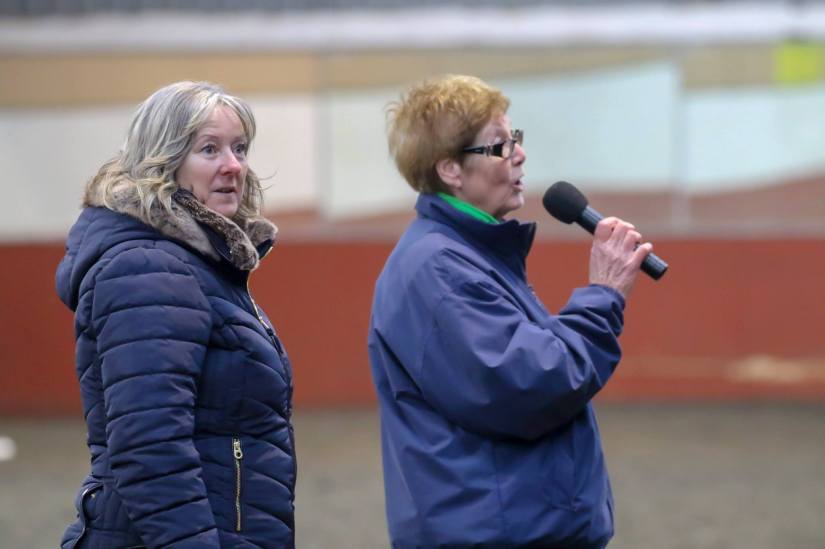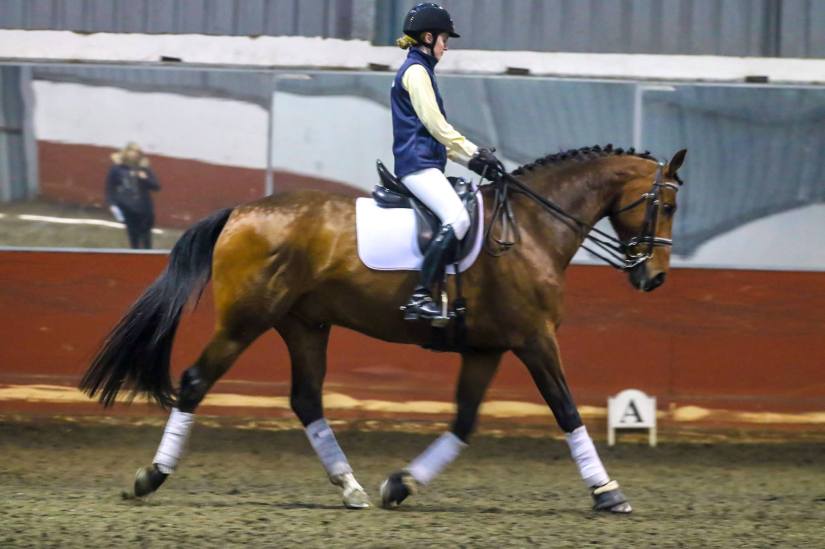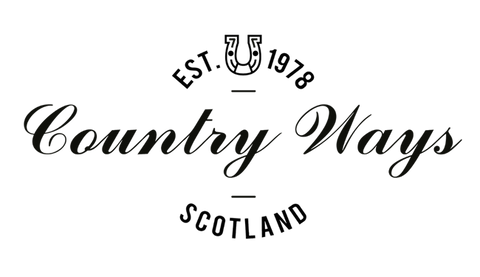By Lynne Clark
Event: Dressage Supporters Scotland, Dressage Demo
Photos: Karen Reid KPhotography
Most of us who have ever ridden a dressage test will have at some point felt confusion/mild irritation/full-blown anger (delete as appropriate! ) at some of the marks on our test sheet. Indeed the very fact that the demo to which this blog is dedicated is called ‘The Mystery of Marks’, denotes that there is often much confusion as to how and why judges award the scores they do.

Enter Jayne Peberdy to illuminate us! As well as being a BD List 1 judge, Jayne is also on the BHS register of Instructors and holds the UKCC Level 3 coaching certificate. She trains a variety of dressage riders ranging from novice to advanced level, with this spectrum being reflected in the demo. The evening consisted of an impressive array of horse and rider combinations – Teresa Smith and Costa Rica II, Mhairi Niven and I Love You Too PC, Sarra Mayberry riding Lorna Anderson’s Danny Boy, Victoria Gladwyn and Sonnersted, and Fenella Ross with Creatzo.
The aim of the evening was to highlight what the judge is looking for at all levels from Prelim to PSG and to find out where those elusive marks come from. Riding a variety of test movements in accordance with their level, Jayne would assess them first with her judge’s cap on, doffing it then for her trainer cap, where she would work the horse and rider through exercises designed to improve the marks, before then putting her judge’s cap back on once more to reassess. In each case, the combination was awarded a higher mark the second time over. The fact that Jayne is both a trainer and judge works very effectively to illuminate where marks are won and lost because she is able to tangibly demonstrate improvements to horse and rider before your eyes. Suddenly marks on paper jump off the page into a more uphill canter or ground covering trot. What is interesting is that no matter what level combinations are competing at, training at home and riding in a test should ALWAYS follow the scales of training. They form the foundation upon which all else should be built, no matter the horse, the movement, or the level. As Jayne observed, the judge never loses sight of the scales of training, and neither should the rider.

Jayne explained from the outset that the purpose of a dressage test is to assess the ability and training of both horse and rider. It is the responsibility of the rider to develop the horses natural ability and not hinder the action you would see in the field. In other words, to nurture what nature has given it. This development is based on the scales of training, which, as Jayne explained, is also what judging is based on. She also emphasised from the outset that marks should be honest with helpful, respectful criticism. Any remarks should never damage or take away a riders confidence. Judging is about responsibility, not power.
As well as the scales of training, judges also work within the perimeters set by the scale of marks which they are able to award each movement.
To add further context to these scales, Jayne used the example of a medium trot. If there is no ground cover, then your mark will be a 4. If you manage but there are problems, say the horse is trying but running on, then your mark will be a 5. If you need more ground cover, a 6, could have been more ground cover, a 7 and if it’s good, then an 8 is awarded. Using one movement as an example to work through the score scale is helpful for the rider to gain a clearer comprehension of just how the pendulum swings from bad to better to good.

Anyway, you’ve entered at A and are making your way (nervously in many cases! ) to the judge at C. What’s the first thing they are looking at? Well, as Jayne explained, the first thing that the judge thinks about is the overall picture. Is the eye drawn anywhere in particular? If it is, this normally indicates a problem as the overall impression should be pleasing to the eye, with nothing particular jumping out. If the overall picture is good and the eye is not drawn to anything in particular, then it’s an 8. The next thing is rhythm and tempo (tempo being the speed of the rhythm), ground cover (back feet tracking over the front), suppleness (both laterally and longitudinal), contact (mouth closed and horse not behind the vertical), balance and acceptance. Indeed this is the criteria which form the basis for assessing any movements, whether it be at Prelim or Grand Prix.
Throughout the demo, Jayne was at pains to stress the importance of balance, balance, balance! Balance is the common denominator of all the scales of training and it’s the yardstick against which judge’s measure any movement. Jayne used the effective analogy of being able to balance a glass of wine on top of the horses head. They should carry themselves in a rhythm in balance and accepting the contact so as not to spill any of that precious wine! Better balance equals better carriage. If the poll gets too low or if the horse’s nose is drawn back behind the vertical (creating a V shape under the neck instead of a U), then the wine gets spilt! (And lets face it, that would probably be a greater travesty to many of us than losing a mark! ) Jayne stressed that the judge is ALWAYS watching the riders balance and how she breaks the rider up into three separate Lego blocks, namely the head/neck/shoulders, middle and pelvis. The rider has a big responsibility to sit in balance because the horse tries to catch the balance when we don’t. If the horses neck is overbent because we aren’t sitting in balance on a circle (where the horses head and neck should be in line with the shoulders) or in a leg yield or half pass (where only the horses eyelashes should be visible), then be prepared for your mark to drop to a 6.

Balance is also the key to developing suppleness (both laterally and longitudinally) and a supple horse is going to be able to perform movements much better. It’s key to the contact too. Riders should never draw the neck in with a backward hand, but should always ride the hind legs forward into the contact, with the horse lifting its back and drawing the neck out. Jayne used the analogy of the horse reaching forward for a bucket of carrots to demonstrate her point. You want to feel like you have two-thirds of the horse moving forward out in front of you (because another thing the judge doesn’t want to see is naggy legs from the rider!) Tellingly, when I have a chat with Jayne during the intermission (see below), she tells me that one of the most common mistakes riders make during a dressage test is using too much hand to balance the horse. The inevitable effect being that you draw the nose in and kill any flow of energy from behind. A bit like driving a car she says, you need to find the biting point between the accelerator and the clutch. If you’re all clutch and not enough accelerator, you’re going to stall.

The judge is also looking for an even contact in both reins too because any uneven pressure in the mouth will reflect in the body. Jayne asked each rider to assess how heavy/light the horse is in each rein and then set them various exercises designed to make the hing leg step into the light rein and even the pressure out. Talking about the legs, Jayne also explained how judges look for ‘air time’ when marking the trot and canter. For example, a canter that you could only fit a sheet of paper underneath is not going to score as highly as one that could fit a sheepskin rug under it. The judge is looking for the horse to jump off the ground like a spring when assessing the quality of the canter. Higher up the levels, when one time changes are required (or any changes between or within the pace), Jayne explains that it should be as clear and sharp as switching a light on or off (and not a dimmer switch!) The horse needs to be adjustable. This prompted an audience member to ask a question about the importance of the horses breeding in dressage. Jayne replied that the degree of athleticism will always be dictated by the quality of the horses base pace, but that a less athletic horse should not be marked down as long as it is balanced.

Throughout the demo, Jayne was at pains to emphasise the importance of getting the basics right. If there is a problem with the basics, then you won’t progress. Simple as that. She explained that training for a dressage test is akin to running a restaurant. All the prep work should be done behind the scenes and the finished article presented at the test. Dressage is not magic she continued, but blood, sweat and tears. It’s about dotting the i’s and crossing the t’s. Basics, basics, basics. Over and over. After all, as Jayne concluded, you have to learn all the letters of the alphabet first, before you can string a sentence together.
At the intermission, I grab a quick Q&A with Jayne…
Q: How do you find the balance between being a coach and a judge? Do the two compliment each other?
A: Yes, they go hand in hand. As a coach I am there to train the riders to perform the movements correctly and as a judge I am there to act as a video camera to tell the rider what I see. Being a coach makes me a more sympathetic judge as I appreciate the hard work that goes into the training.
Q: Do you ever give out those elusive 10’s?
A: Yes, but not often. It has to be very special where you can’t imagine the movement done any better. Something that gives you goose bumps!
Q: What’s the biggest mistake riders make during a dressage test?
A: Allowing their nerves to rush the horse out of balance and using too much hand to try and balance the horse.
Q:What’s the best piece of advice you would give for riding a test?
A: Ride accurately and make sure you know your test to start with! Follow the scales of training at all times and ride the horse you have that day.
Q: How can riders ensure they have the best warm up that allows them to translate the work they do at home into a test?
A: When warming up, have a system. Know your horse and what works for it and stick to it. Don’t change everything up just because you are suddenly in a collecting ring and not at home. Follow the scales of training at all times and always let them set the tone for your riding.
L.C
Don’t miss our next event: A Dressage Master Class with Daniel Watson. Sponsored by Coutnry Ways and Ardene House Equine Vets. Tickets are still available. Please visit our facebook events page for details.














